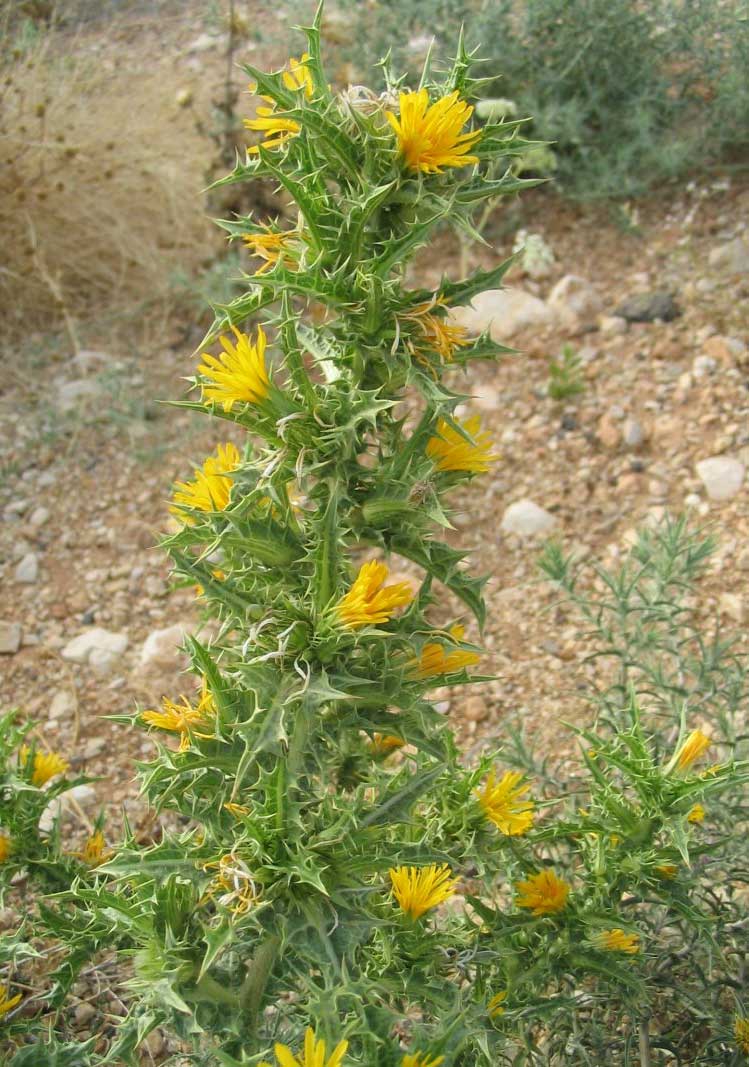
Scolymus hispanicus
Classification System: APG IV
Superregnum: Eukaryota
Regnum: Plantae
Cladus: Angiosperms
Cladus: Eudicots
Cladus: Core eudicots
Cladus: Asterids
Cladus: Campanulids
Ordo: Asterales
Familia: Asteraceae
Subfamilia: Cichorioideae
Tribus: Cichorieae
Subtribus: Scolyminae
Genus: Scolymus
Species: Scolymus hispanicus
Subspecies: S. h. subsp. hispanicus – S. h. subsp. occidentalis
Name
Scolymus hispanicus L., Sp. Pl. 2: 813 (1753).
Synonyms
Homotypic
Myscolus hispanicus (L.) D.Dietr., Syn. Pl. 4: 1333 (1847).
Distribution
Native distribution areas:
Continental: Europe
Regional: Middle Europe
Switzerland (alien
Regional: Southwestern Europe
Baleares (Ibiza-Formentera, Mallorca, Menorca), Corse, France, Portugal, Sardegna, Spain.
Regional: Southeastern Europe
Albania, Bulgaria, Greece, Italy, Kriti, Romania, Sicilia (Sicily, Malta), Turkey-in-Europe, Yugoslavia (Bosnia-Herzegovina, Croatia, Macedonia, Montenegro, Serbia, Slovenia)
Regional: Eastern Europe
Krym, South European Russia, Ukraine.
Continental: Africa
Regional: Northern Africa
Algeria, Egypt, Libya (alien), Morocco, Tunisia.
Regional: Macaronesia
Azores (Faial, Graciosa: alien), Canary Islands (Gran Canaria, Gomera, Hierro, Tenerife (doubtfully native), La Palma, Fuerteventura, Lanzarote).
Continental: Asia-Temperate
Regional: Caucasus
North Caucasus, Transcaucasus (Azerbaijan, Gruziya)
Regional: Western Asia
Cyprus, East Aegean Islands, Iran, Lebanon-Syria (Lebanon, Syria), Palestine (Israel, Jordan), Turkey
Continental: Australasia (all introduced)
Regional: Australia
New South Wales, Victoria.
Continental: Northern America all introduced)
Regional: Northeastern U.S.A.
New York, Pennsylvania.
Regional: Southwestern U.S.A.
California.
Regional: Southeastern U.S.A.
Alabama.
References: Brummitt, R.K. 2001. TDWG – World Geographical Scheme for Recording Plant Distributions, 2nd Edition
References
Primary references
Linnaeus, C. 1753. Species Plantarum. Tomus II: 813. Reference page.
Additional references
Vázquez, F.M. 2000. The genus Scolymus Tourn. ex L. (Asteraceae): taxonomy and distribution. Anales del Jardin Botánico de Madrid 58(1): 83–100. PDF Reference page.
Links
Govaerts, R. et al. 2020. Scolymus hispanicus in Kew Science Plants of the World online. The Board of Trustees of the Royal Botanic Gardens, Kew. Published on the internet. Accessed: 2020 Sep 21. Reference page.
Hassler, M. 2020. Scolymus hispanicus. World Plants: Synonymic Checklists of the Vascular Plants of the World In: Roskovh, Y., Abucay, L., Orrell, T., Nicolson, D., Bailly, N., Kirk, P., Bourgoin, T., DeWalt, R.E., Decock, W., De Wever, A., Nieukerken, E. van, Zarucchi, J. & Penev, L., eds. 2020. Species 2000 & ITIS Catalogue of Life. Published on the internet. Accessed: 2020 Sep 21. Reference page.
Euro+Med 2006 onwards: Scolymus hispanicus in Euro+Med PlantBase – the information resource for Euro-Mediterranean plant diversity. Published on the internet. Accessed: 2020 Sep 21.
USDA, ARS, Germplasm Resources Information Network. Scolymus hispanicus in the Germplasm Resources Information Network (GRIN), U.S. Department of Agriculture Agricultural Research Service. Accessed: 07-Oct-06.
Vernacular names
català: Cardellet
Deutsch: Spanische Golddistel
English: common golden thistle, Spanish oyster thistle
español: cardillo, cardo de olla, tagarnina
suomi: Espanjankultaohdake
français: Chardon d'Espagne
Scolymus hispanicus, the common golden thistle or Spanish oyster thistle, is a flowering plant in the genus Scolymus in the family Asteraceae, native to southern and western Europe, north to northwestern France.
It is a herbaceous biennial or short-lived perennial plant growing to 80 cm tall, with spiny stems and leaves. The flowerheads are bright yellow to orange-yellow, 2–3 cm diameter
Uses
Since at least the time of Theophrastus in ancient Greece, this plant has been known for medicinal and culinary uses. Although it has been cultivated at times, currently most of the plant which is consumed comes from harvesting wild plants.[1] It is very popular in almost every province of Spain, where it is usually eaten in stews during spring. It is also used in salads and soups, and it is served with scrambled eggs in Extremadura and Andalusia, Spain, where it is called tagarnina. In the sixteenth century in Salamanca, the washed young plants used to be eaten with their root, either raw or in stews with meat.
In parts of southern Italy, the leaves are only gathered during Holy Week, after which they are used to bake a meat pie to be eaten on Easter.[2]
References
"Spanish salsify (Scolymus hispanicus)".
Pieroni, Andrea (2005). Prance, Ghillean; Nesbitt, Mark (eds.). The Cultural History of Plants. Routledge. p. 39. ISBN 0415927463.
Flora Europaea: Scolymus hispanicus
Retrieved from "http://en.wikipedia.org/"
All text is available under the terms of the GNU Free Documentation License

